These are the morning committee meetings. The afternoon full board meeting is here.
Live video here. Some live blogging below. Usual disclaimer: my opinion of what people said, should have said, meant, or should have meant.
Highlights (to be updated):
- Still no information from Trustee Susan Gary on the secret meetings tomorrow.
- 8 months after UO’s Chief Auditor left in frustration with the lack of cooperation from the VPFA’s office, the office is still in disarray. Just as UO is going through an administrative realignment process where good, independent information is key, the UO board and the President have no good independent information. Which gives Moffitt and Shelton a lot of power.
- Gigabits.
- Jamie Moffitt reports that the budget is “run rate even”. Turns out the union raises didn’t break the bank after all. No one asks her about her $10M gift to the law school, and $5M to AAA.
Thursday, June 2, 2016 at 8:00 am. Executive and Audit Committee. Materials (now updated w/ audit).
Ford Alumni Center, Giustina Ballroom
Convene – Call to order and roll call – Approval of December 2015 EAC minutes (Action)
1. Quarterly Audit Report and FY2016‐17 Audit Plan, Chief Auditor Trisha Burnett
From the materials: During FY16, the Office of Internal Audit (Internal Audit) met with the Director of Enterprise Risk Services (ERS) and discussed the risk assessment process. It was determined that Internal Audit would collaborate with ERS for the enterprise risk assessment during early 2016. However, this collaborative process was subsequently rescheduled for fall 2016. Internal Audit has experienced nearly complete turnover in staffing during FY16. As a result, risks identified during the prior year risk assessment process have not been fully evaluated. For the FY17 audit plan, Internal Audit will revisit information gathered during the prior year as a basis for the audit plan. This includes review of the prior year audit plan, the results of the Strategic Enterprise Risk Management & Compliance (SERMC) committee risk assessment process, and prior year interviews conducted by Internal Audit. Feedback from senior leadership will be obtained to identify necessary adjustments.
Many processes and systems are currently being evaluated by management for potential changes. Time will be allocated on the audit plan to allow for advisory services in these areas. Internal Audit will advise on internal controls, safety, security, compliance, efficiency, and effectiveness. The progress and action plans will be included in Board communications.
[Given all this turmoil, you’d think that the Trustees might get a little time to go through the latest audit? Nope:] “Note: The quarterly audit report will be provided at the meeting.” And it is, in the newly updated supplementary material, here. Pretty skimpy. The Athletics Risk Assessment is still on hold, as it has been for a year.
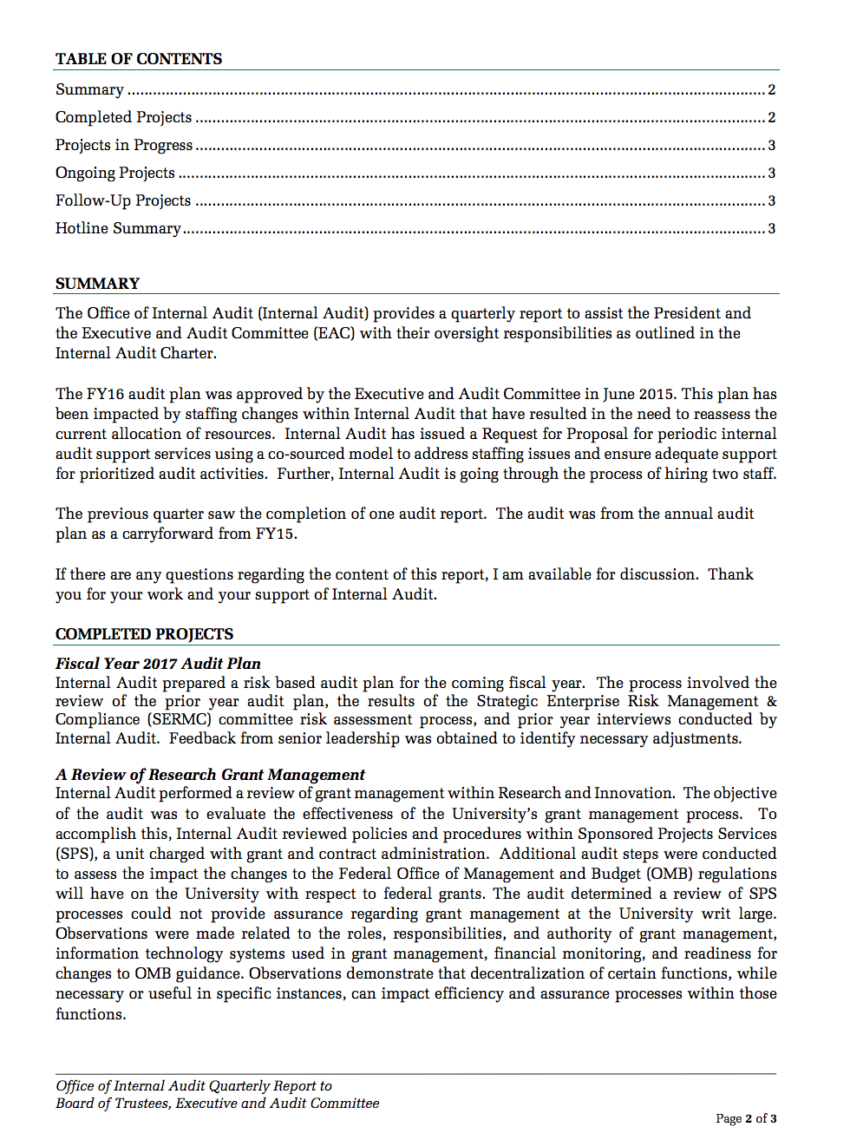
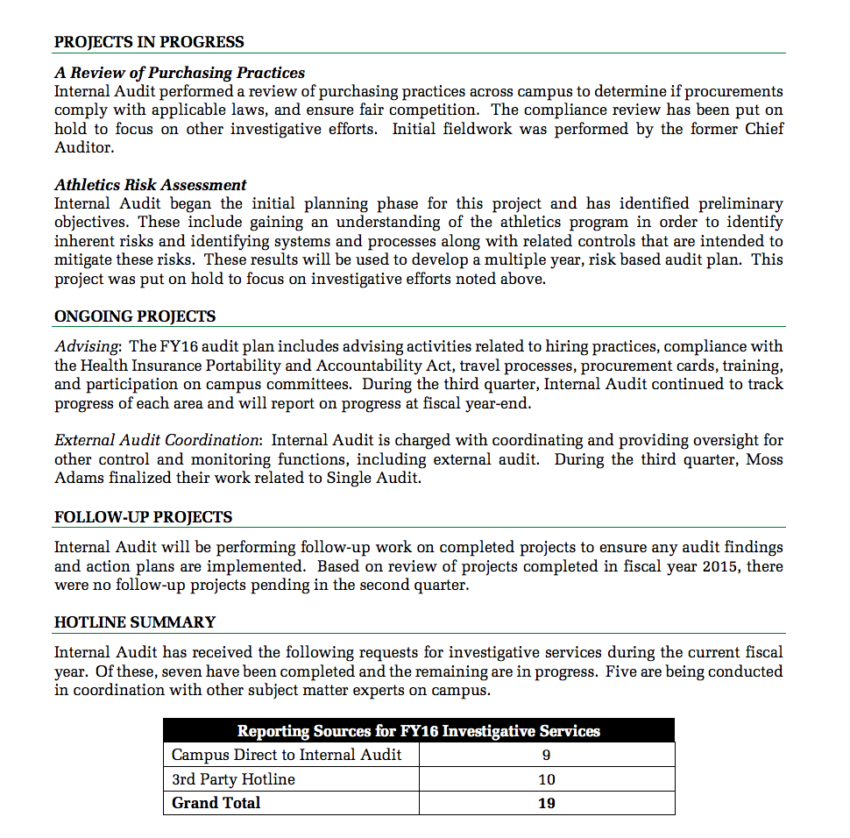
UO’s first internal auditor was hired in May 2014, and left in October 2015. She was very frustrated by the lack of cooperation from VPFA Jamie Moffitt – at one point telling me UO Matters had information she couldn’t get from the VPFA. One of her assistant’s also left. Her other assistant, Trisha Burnett, was promoted w/o an external search.
Burnett’s presentation basically involves explaining the fact that in the two years the office has been in place it has conducted almost no internal audits. I would think the board – which has the obligation to exercise due diligence – would be pushing hard on this. They are not.
Burnett says that she’s now restarting the audit plan Muirhead put forward last year. But first she has to hire two new staff, and perhaps hire an external firm to help. It’s now been eight months since Muirhead left, and nothing substantive has been done. Not even a hire. Amazing.
Here’s the new 2017 audit plan:
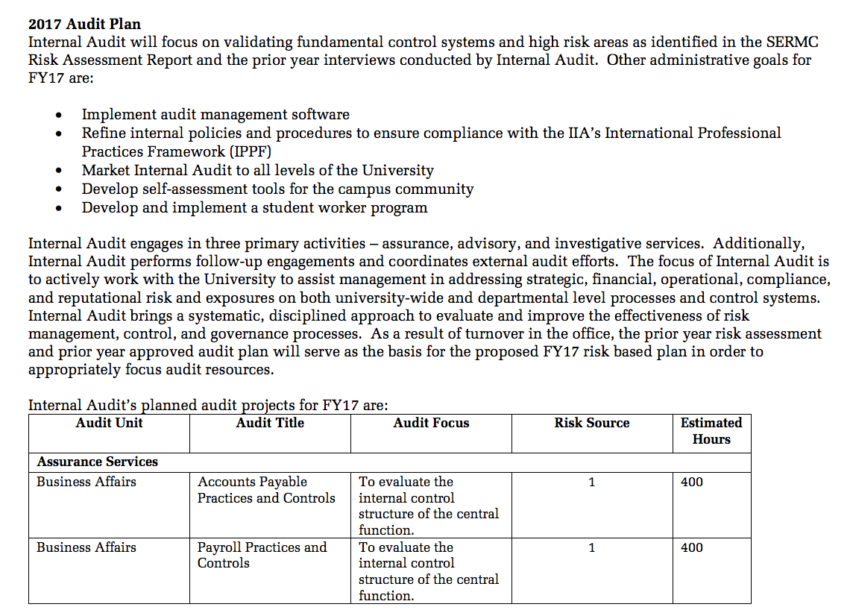
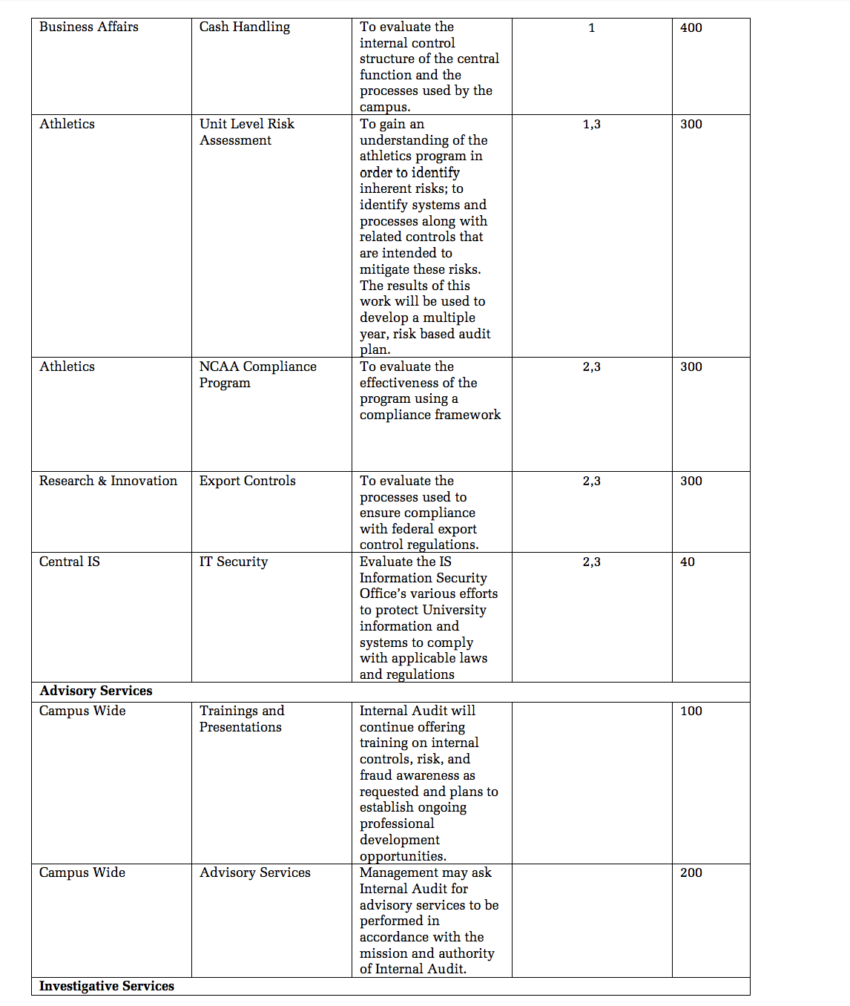
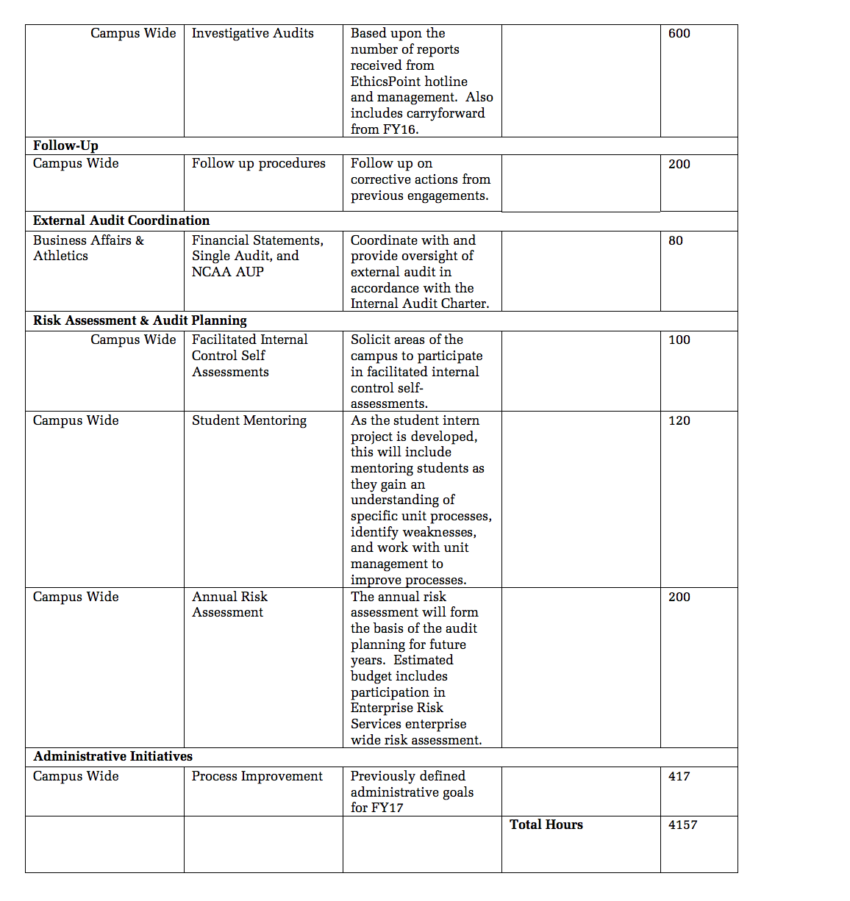
And here’s last years plan, which the board approved almost exactly a year ago:
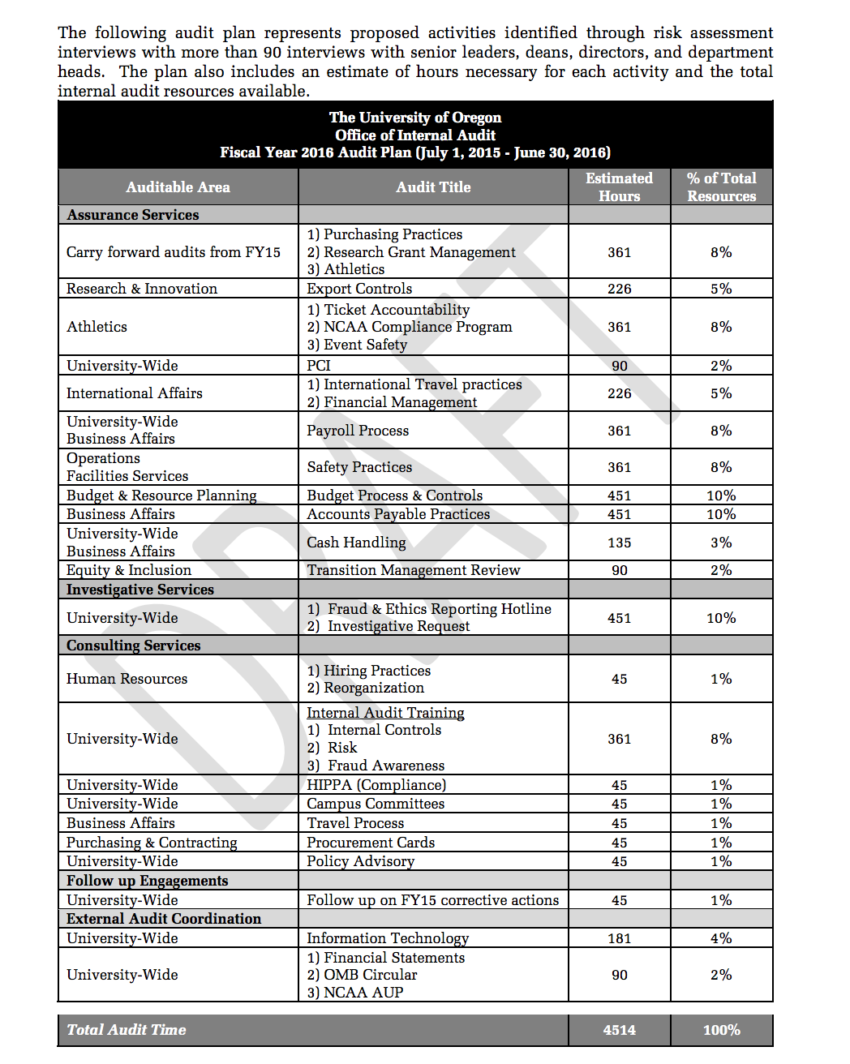
The Chief Auditor reports to the Board of Trustees, and is central to their ability to do their due diligence. Virtually none of the work above was done. You’d think the board, and especially Chuck Lillis, would be a little more concerned. I wonder what their D&O insurance covers?
Lillis got into a bit of D&O trouble when he was on the Washington Mutual Board, which went through one of the largest bankruptcies in US history:
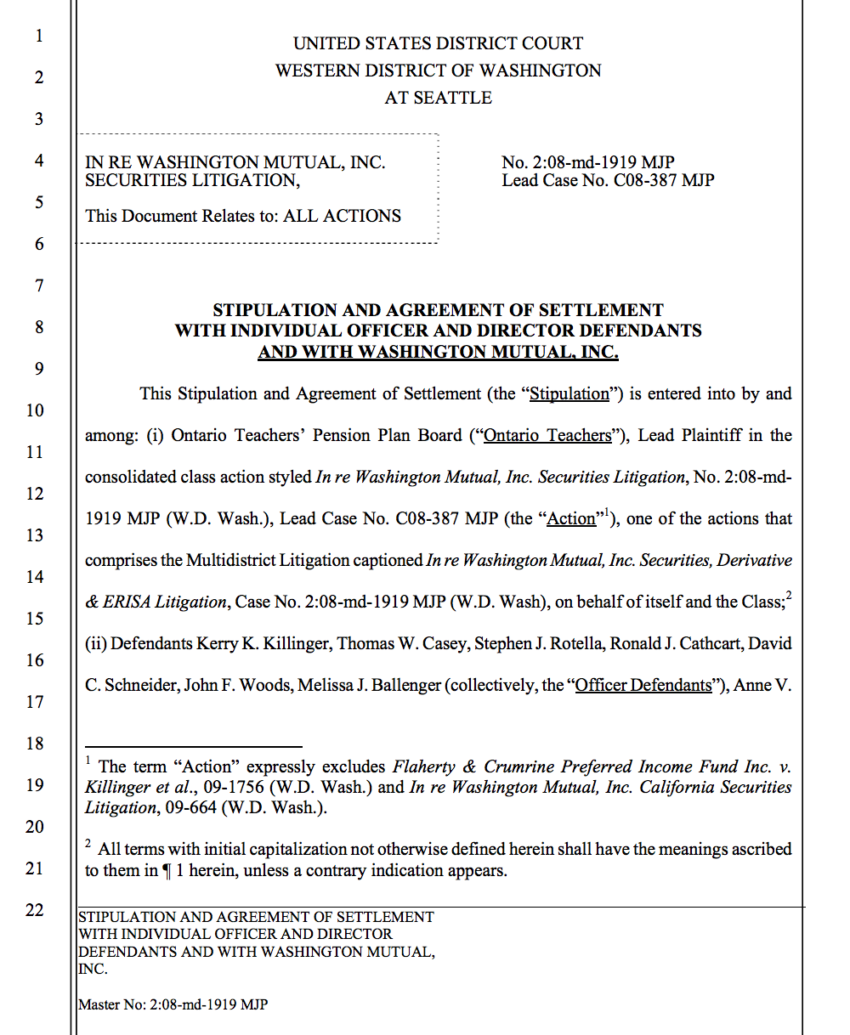
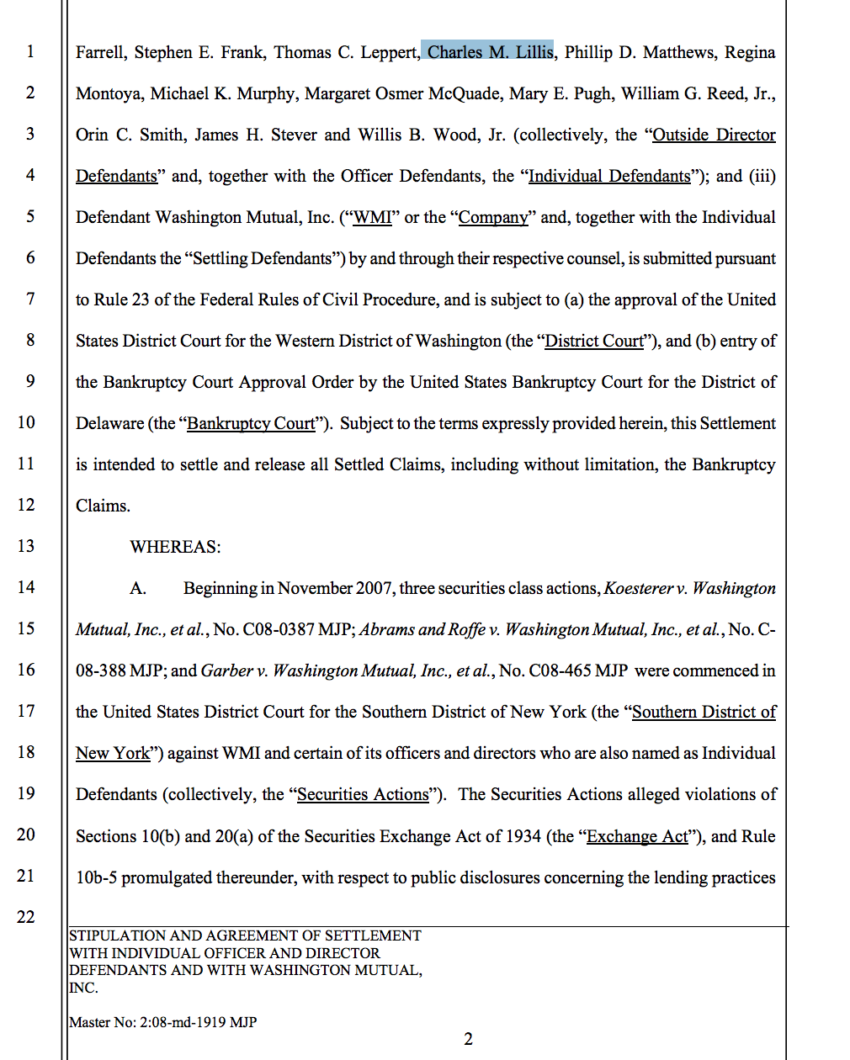
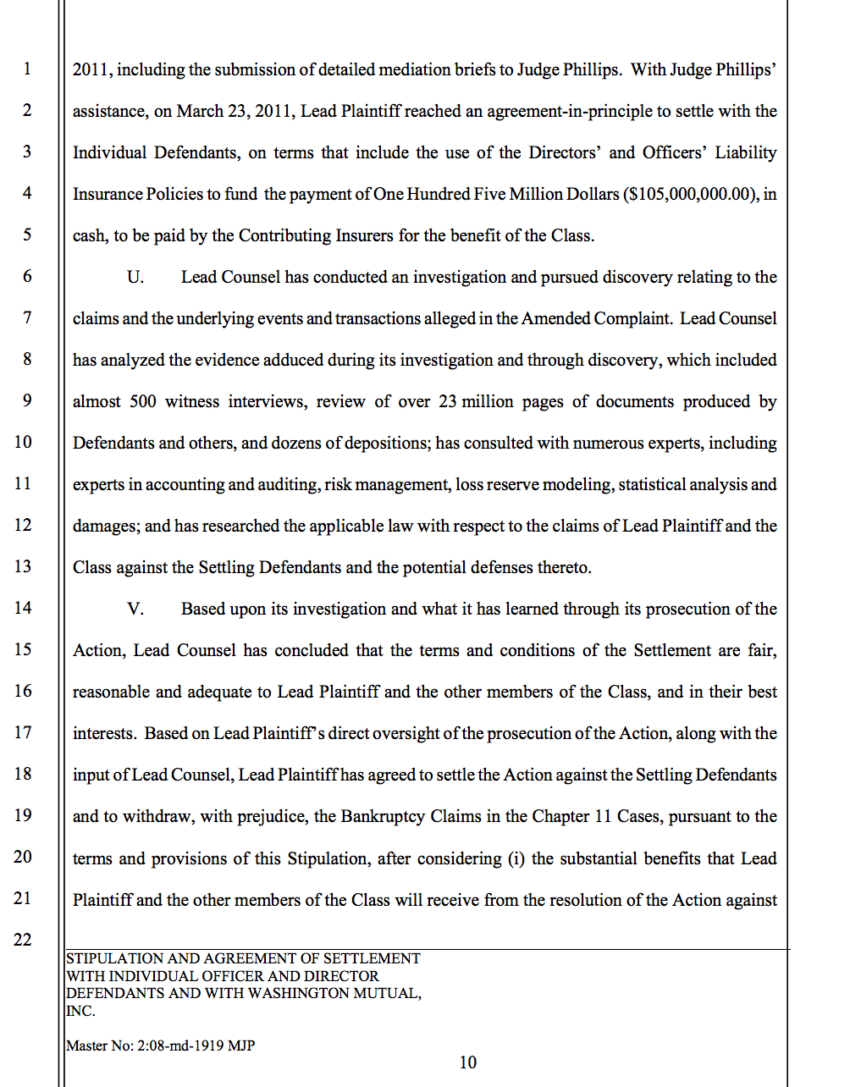
The D&O insurance company then sued the WaMu directors, including Lillis, arguing that they’d failed to exercise their due diligence and that they should be personally liable. The lawsuits finally ended with a $37M payout. There was another $49M for ERISA violations.
For some reason Lillis’s WaMu service is not mentioned in his UO trustees bio: “…. and has served on the boards of private and public companies including Williams Co., Medco and SuperValu. He is a member of the board of SomaLogic …”
2. University IT and Computing Priorities Update, Interim CIO Chris Krabiel; Professor of Computer and Information Science and IT Leadership Team Member Joe Sventek
Good presentation, tough problems.
Thursday, June 2, 2016 at 9:00 am. Finance and Facilities Committee Meeting. Materials.
Convene
– Call to order and roll call
– Approval of March 2016 FFC minutes (Action)
– Public comment
1. Naming of Certain University Facilities
– Berwick Hall (Oregon Bach Festival), Executive Director of the Oregon Bach Festival Janelle McCoy
– Bowerman Track & Field Complex, University of Oregon Foundation President and CEO Paul Weinhold
2. Contract Approval – Multimedia Rights Agreement (Action), Director of Intercollegiate Athletics Rob Mullens
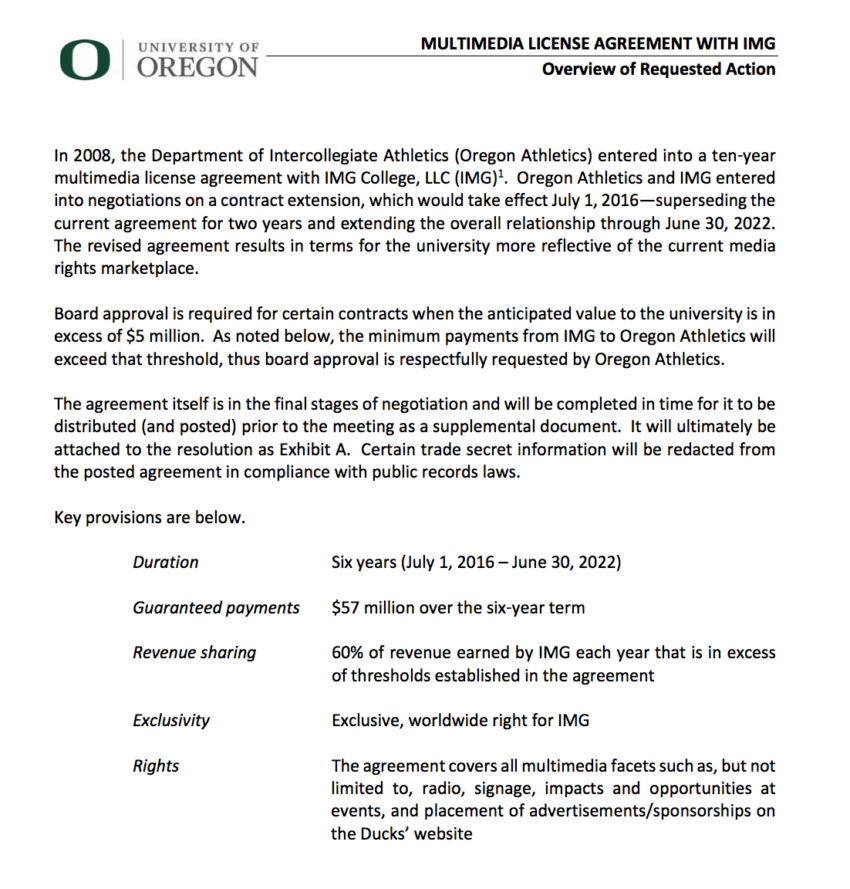
Here’s hoping Eric Roedl read this contract a little more carefully than the Bowl Insurance deal. The board has some good questions. Lillis asks AGC Bryan Dearinger what he thinks of the contract. Dearinger says it’s more transparent, more flexible. GC Kevin Reed says that the current contract prohibited UO from shopping around for competitive bids, they had to get an “independent evaluation” to use in renegotiating with IMG. I wonder which previous UO GC approved that clause? Grier? Geller? Park?
The Ducks now need to renegotiate their Nike deal, which expires next year. It’s a great deal for the coaches and JH administrators who want free shoes, but not so good for UO. Some old links:
12/9/2014 update: Which football championship team has the worst Nike contract? The Ducks.
From Matthew Kish in the Portland Business Journal:
Here’s a breakdown of Nike’s [athletic apparel] deal with each university in the playoffs. The terms cover the 2014-15 academic year [reordered in descending order of cash payment]:
– Ohio State: $2.5 million in equipment and apparel and nearly $1.5 million in cash. The university also gets $150,000 in discretionary apparel, typically for athletic department personnel.
– Florida State: $3 million in equipment and apparel and $1.4 million in cash.
– Alabama: $2.8 million in equipment and apparel, $780,000 in cash.
– Oregon: $2.2 million in equipment and apparel and $600,000 in cash. The university also gets $185,000 in discretionary apparel, typically for athletic department personnel.
But hey, we’re #1 in “discretionary apparel”!
From what I can tell from Dave Hubin’s redacted public records, $30K of that goes to our colleagues in Johnson Hall, presumably including some who signed off on the contract. So they’ll be looking good on their Jan 1 Rose Bowl junkets.
2/3/2014 update: Under Armour pays Notre Dame $9M, Nike pays UO $600K
Nike just signed Tennessee to a new deal for $1M cash a year, plus $2M signing bonus.
1/23/2014: Our Uncle Phil drives a tough bargain. Nike’s merchandising deal with UO pays us just $600K a year. Meanwhile Notre Dame just closed on a 10 year deal with Nike competitor Under Armour for ~$9M a year. Bloomberg financial news has a report here:
3. Quarterly Finance Report, Vice President for Finance and Administration/CFO Jamie Moffitt
The usual, it’s “run rate even”. Tuition revenue is up – students taking more credits – but so are employee costs. Next year costs will be up more but the tuition increases will cover it.
Willcox: So we could have had a smaller tuition increase?
Curry: If we’re this tight, are we going to have to look at cuts again? Schill: We always need to be thinking about cuts and efficiencies. [too bad we still don’t have a functioning internal audit office to look for those efficiencies.]
Schill: Worried about potential for a state budget deficit, state cuts. Would have been irresponsible to have not increased tuition by the amounts we did.
Curry: Are the faculty being advised on the importance of getting students to take more classes?
Schill: Yes, but it’s going to take a culture shift on the part of the students.
Paustian: Do we have the faculty to teach students, if they all start taking more classes?
Moffitt: We’re hiring more faculty.
Schill: We’re gearing up to do this, but you’re absolutely right, we need to work on supply, not just demand.
4. Fiscal Year 2016‐17 Capital and Operating Expenditure Authorizations (Action), President Michael Schill and Vice President for Finance and Administration/CFO Jamie Moffitt
Moffitt: We secured AA2 and AA- ratings, got great rates, debt will be used to pay for new dorms, working capital for athletics, etc.
See page 17 of your packet here:
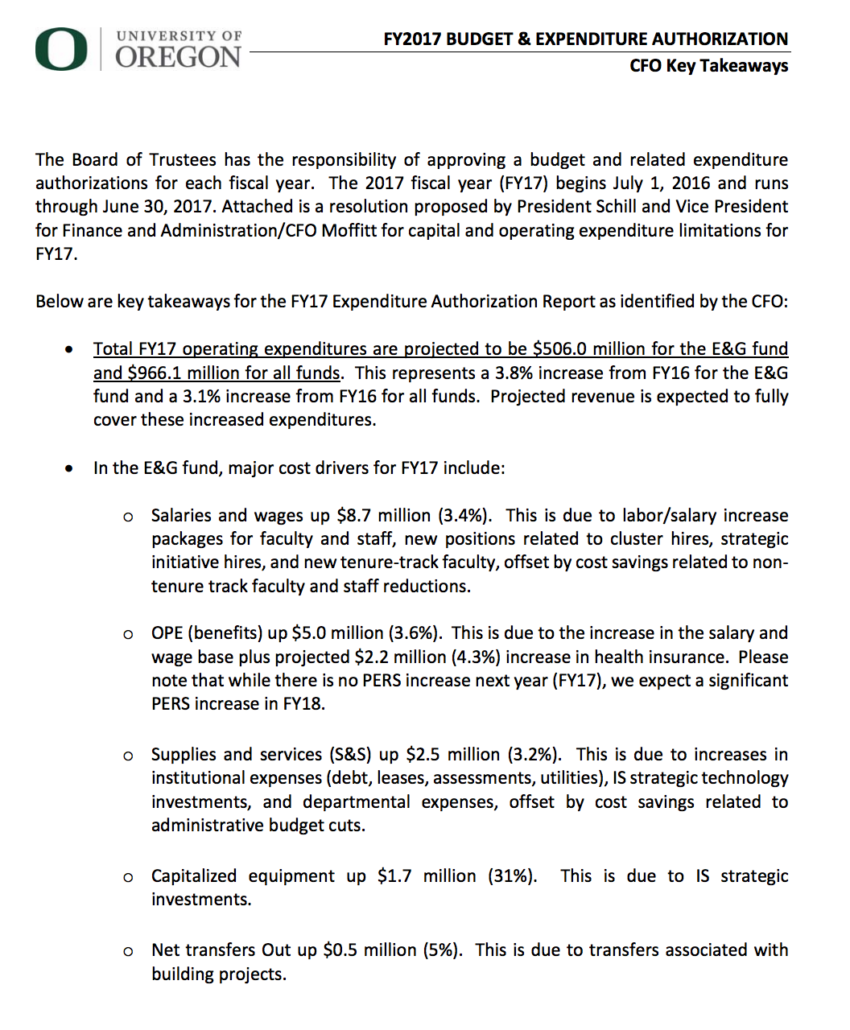
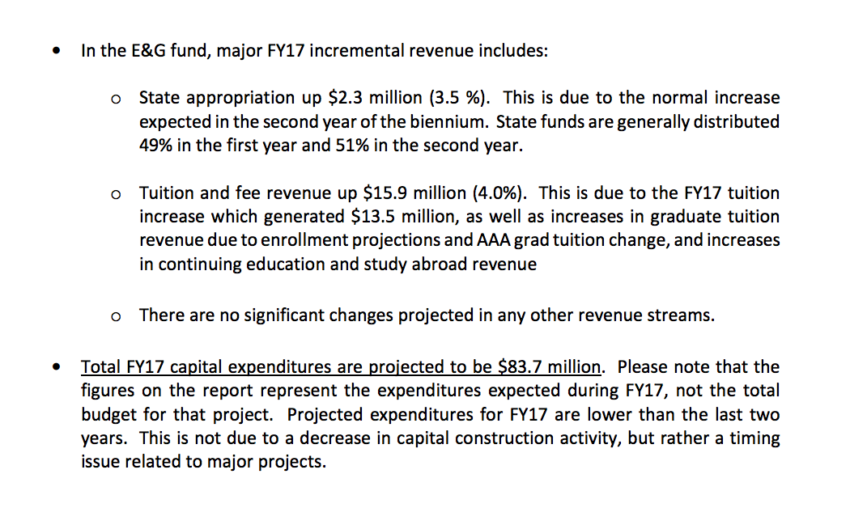
No significant increase in revenue from philanthropy? Oh, right, this is UO’s academic budget, not the Duck’s budget.
Question about the cuts – which I don’t see very well documented in the materials.
Moffitt: I had to personally cut $1M from my budget, it was very difficult.
Curry: What’s going on with the large increases in “supplies and services”?
Moffitt: I’ll look into it.
Wilcox: Why don’t you break it down more?
[Very good to see the board getting more skeptical about Moffitt’s budget reports. Their auditor really should be helping with this.]
Willcox to Moffitt: CAS Dean Marcus gave the campus very careful explanations for his budget cuts. It would help build trust if your office would do that for the rest of the campus cuts as well. [I tried to get that info through the SBC. Didn’t get it.]
Moffitt: We’ve also been charged with finding additional 3% in cuts over next several years.
Willcox: Pushes back, calls for more transparency.
Estimated cash payments for 2016-17 capital projects:
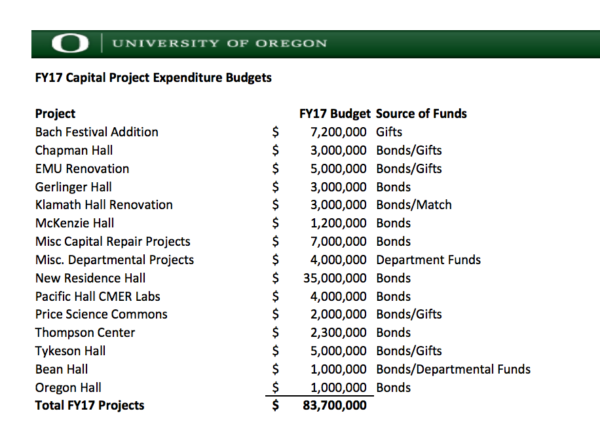
Where’s the athletics? Hayward Field tart-up?
Thursday, June 2, 2016 at 10:30 am. Academic and Student Affairs Committee. Materials.
Convene
– Call to order and roll call
– Introductory comments and agenda review
– Approval of March and April 2016 ASAC minutes (Action)
– Public comment
1. Update on University Ombuds Program and Initiatives, Interim Ombudsperson Jennifer Reynolds
Reynolds gives a good, brief report. Not quite as comprehensive and interesting as former Ombud Bruce McAllister’s:
2. Classified Staff
Deep Mistrust of AA/EO
Classified staff report high levels of distrust and low levels of confidence in the
fairness, competence, and responsiveness of the University’s AA/EO function.
Examples of concerns reported include reaching decisions and conclusions about
employee medical fitness without adequate input from an employee’s physician,
sharing information outside of the appropriate confines of HR record-keeping, and
generating shadow files. Ombuds does not independently investigate concerns and
draws no conclusions beyond noting a pattern of reported perception. I also note that
perception does not necessarily equate to fact, but patterns are important to the
acceptance and long-term efficacy of any particular program.
Patterns of abusive management style in trades positions.
Ombuds received extensive reports of managers in the “blue collar” positions being
subjected to perceived retaliation for surfacing safety concerns or physical injury.
Patterns of perceived avoidance of “Weingarten” protections
Ombuds received reports that employees felt “ambushed” in meetings that were
announced with a more generic topic, but in actually included disciplinary action,
which the employee perceived implicated certain NLRB protections.
3. Officers of Administration and Other Non-union Positions
Widespread perception of a lack of functional protections equivalent to those
available to unionized employees.
Officers of Administration consistently report a perception of an utter lack of due
process protections associated with their position. They report an incomprehensible
and unusable employee grievance process and a widespread sense of vulnerability.
Further, employees in this category report that they have no sense of confidence that
their managers will exercise progressive discipline or even candidly communicate
performance issues and expectations. Rather, these employees report that they
perceive that their managers simply use the annual contract renewal/non-renewal
process to winnow out non-classified personnel perceived to have performance
issues.
4. Faculty
Widespread perception of an academic culture that accepts abrasive behavior
and harassment.
There was a strong pattern of concerns reported among faculty that, as colleagues,
faculty are very hard on one another, and that department heads, deans, and other
administrators do not enforce standards of civility.
Perceptions that University “administration” is not transparent
A significant number of faculty reported that they do not trust “Johnson Hall,” and
that “Johnson Hall” resists sharing information and reacts to faculty who speak out defensively and with a tendency towards laying blame or finding faulty with the source of the particular comments.
Polarization … For a large portion of my tenure as ombuds, it was clearly apparent that faculty had splintered into subgroups around polarizing issues, such as the role of NCAA athletics on a campus, or the appropriate role of the President in challenging personnel or student issues. This extreme polarization led to a widely perceived sense that “Johnson Hall” was operating with a “bunker mentality” and refused to engage. The more that “Johnson Hall” was perceived as refusing to engage, the more activated groups of faculty became. I note that the polarization was not focused exclusively on the Administration versus Faculty vector, but included polarization among faculty, some who perceive that the UO Matters blog inhibits safe and open communication, in itself, and others who believe that the venue provides a valuable independent forum.
2. Classified Staff
Deep Mistrust of AA/EO
Classified staff report high levels of distrust and low levels of confidence in the
fairness, competence, and responsiveness of the University’s AA/EO function.
Examples of concerns reported include reaching decisions and conclusions about
employee medical fitness without adequate input from an employee’s physician,
sharing information outside of the appropriate confines of HR record-keeping, and
generating shadow files. Ombuds does not independently investigate concerns and
draws no conclusions beyond noting a pattern of reported perception. I also note that
perception does not necessarily equate to fact, but patterns are important to the
acceptance and long-term efficacy of any particular program.
Patterns of abusive management style in trades positions.
Ombuds received extensive reports of managers in the “blue collar” positions being
subjected to perceived retaliation for surfacing safety concerns or physical injury.
Patterns of perceived avoidance of “Weingarten” protections
Ombuds received reports that employees felt “ambushed” in meetings that were
announced with a more generic topic, but in actually included disciplinary action,
which the employee perceived implicated certain NLRB protections.
3. Officers of Administration and Other Non-union Positions
Widespread perception of a lack of functional protections equivalent to those
available to unionized employees.
Officers of Administration consistently report a perception of an utter lack of due
process protections associated with their position. They report an incomprehensible
and unusable employee grievance process and a widespread sense of vulnerability.
Further, employees in this category report that they have no sense of confidence that
their managers will exercise progressive discipline or even candidly communicate
performance issues and expectations. Rather, these employees report that they
perceive that their managers simply use the annual contract renewal/non-renewal
process to winnow out non-classified personnel perceived to have performance
issues.
4. Faculty
Widespread perception of an academic culture that accepts abrasive behavior
and harassment.
There was a strong pattern of concerns reported among faculty that, as colleagues,
faculty are very hard on one another, and that department heads, deans, and other
administrators do not enforce standards of civility.
Perceptions that University “administration” is not transparent
A significant number of faculty reported that they do not trust “Johnson Hall,” and
that “Johnson Hall” resists sharing information and reacts to faculty who speak out defensively and with a tendency towards laying blame or finding faulty with the source of the particular comments.
Polarization … For a large portion of my tenure as ombuds, it was clearly apparent that faculty had splintered into subgroups around polarizing issues, such as the role of NCAA athletics on a campus, or the appropriate role of the President in challenging personnel or student issues. This extreme polarization led to a widely perceived sense that “Johnson Hall” was operating with a “bunker mentality” and refused to engage. The more that “Johnson Hall” was perceived as refusing to engage, the more activated groups of faculty became. I note that the polarization was not focused exclusively on the Administration versus Faculty vector, but included polarization among faculty, some who perceive that the UO Matters blog inhibits safe and open communication, in itself, and others who believe that the venue provides a valuable independent forum.
Reynold and Reed then discuss the progress on hiring a permanent replacement for MacAllister – sounds like finalists should be on campus in a month or so. Here’s hoping that there will plenty of time for meetings with OA’s, staff, faculty, etc.
Willcox asks about what sort of cases she’s getting. Reynolds: About 100 so far, about 1/4 students, 1/3 OAs. Appreciates her work for SEIU staff. [I’ve met with her too, she’s very helpful.]
2. Overview of Graduate Education at the UO, Graduate School Dean Scott Pratt
Pratt: We assess graduate programs, provide resources, serve as center for innovations. Talks about role in staying in the AAU. PhD enrollment is small relative to other AAU’s, but delivers in terms of time to degree and completion.
Pratt doesn’t have a 5 year plan, he’s got a 1 year plan. And he’s already started implementing it, with new first year fellowships funded by Schill’s office. $800K recurring, plus $100K for underrepresented minorities. These fellowships and top-off awards are essential for getting top students, who are heavily recruited by other universities.
Pratt got this money out to the departments out very quickly. Entering PhD students increased from 188 last year to 248 this year. Largest entering class in 5 years – and high quality ones, more diverse. Fabulous.
Ford: Very happy with the high quality of UO’s graduate education – wonders if the state and the HECC supports it, or, as Schill said yesterday, that they just wanted us to be a little better than Idaho?
Schill: We’re going to need support from Ben Cannon and HECC – including funding for new science labs – to continue to make progress. We’ve have enough lab space for only one more year of science hires. Then we’re full-up. The state prioritizes undergrad access, gives us very little for research. The future of this state is going to depend on making the transition to the new information based economy – and we need this.
Schill: Want to congratulate Pratt for doing more than I thought he good do with this $800K. We need to find more resources for more of this.
Pratt: UO’s research is competitive on a national, international scale. Oregon needs this.
Curry: What are the stellar programs? Pratt: Most selective in terms of enrollment are Psychology. Chemistry, Bio. Philosophy, English. Curry: Why? Pratt: Because of the faculty. Prospective graduate students come to UO because they see the faculty’s research and want to be part of it.
Schill: One new thing Pratt did was to allocate funds on the basis of quality. [Unlike Shelton’s budget model, which rewards departments for teaching low cost courses with easy A’s. Why is Shelton still in charge of that?]
3. University Diversity, Equity and Inclusion Initiatives Update, President Michael Schill and Vice President for Equity and Inclusion Yvette Alex‐Assensoh
Here are my comments from when this was presented to the Senate in January:
Review of IDEAL Framework; Sari Pascoe, Office of Equity & Inclusion
Here’s a link to the final version of UO’s 2006 Diversity plan. This was sent to the Senate by President Frohnmayer and approved after a contentious set of meetings, during which it came out that the administration had agree to hire a diversity director and prepare a diversity plan as part of the legal settlement with Joe Wade, an African-American administrator who had sued Frohnmayer and Provost John Moseley for discrimination in hiring. Frohnmayer had kept this hidden from the faculty and even from the person he hired as Diversity Director.
That diversity director left, and was replaced by Charles Martinez (Education). After faculty complaints about the text and the process, Martinez heavily revised the plan and Frohnmayer brought it to the Senate. There was a healthy debate, the minutes are here. One snippet:
Senator Chris Ellis, economics, then rose to oppose the motion. He felt everyone in the room believed diversity was a good thing because they cared about some of the underlying problems in our society. However, Senator Ellis felt that the current plan was fundamentally and logically flawed, and as such, could not achieve its goals. He noted that there was a large body of literature on the economics of education and he introduced some issues raised in that literature. One issue is that economically disadvantaged people historically do poorly in education, and Blacks and Hispanics have been historically poor, thus there are not enough persons in these underrepresented groups to fill the “pipeline” to become college undergraduates and graduates from which to make hires. He suggested the proposed plan does not address the pipeline issue. He concluded by noting that there is a large bureaucracy with a large budget devoted to diversity already, and he was concerned about resource questions. He proposed putting our resources into resolving the pipeline issue.
The plan was approved. It included a very expansive definition of diversity, and explicit recognition that “diversity of thought” was of primary interest to the university, given our academic mission. Income and class and political beliefs were also included:
The language in the newly proposed 2015-16 diversity plan, here, is much less inclusive, focusing on race and ethnicity, gender, sexual orientation, and disability status:
And
Sullivan: I asked VP Alex-Assensoh what the Senate could do to help with diversity, she asked us to get involved in the IDEAL process.
More on the OEI page here.
[Sorry, I’m listening not blogging.]
Psaki: Concerned about the faculty review part. During bargaining, the faculty union was concerned that some faculty, particularly women and minorities, where not being recognized or rewarded for their work on equity and inclusion. The union and the administration agreed to language on this. In contrast this plan imposes a new unfunded time-mandate on all faculty, which was explicitly not part of what we agreed to.
Sullivan: The Senate will post this plan for discussion, and this is an example of the sorts of issues that should be raised.
Schill: Will have Deans prepare diversity plans, and will evaluate them on these.
Schill then goes into the Black Student Demands, and responses. Thirteen demands, 6 responses so far.
[Sorry, I’m too hungry to blog. The Trustees got bacon and eggs, the peanut gallery got coffee. He’d better wrap this up soon, or nobody is getting lunch.]
Colas: Asks if the Board can meet with the Black Students themselves.
Lunch: Full board starts at 12:45.
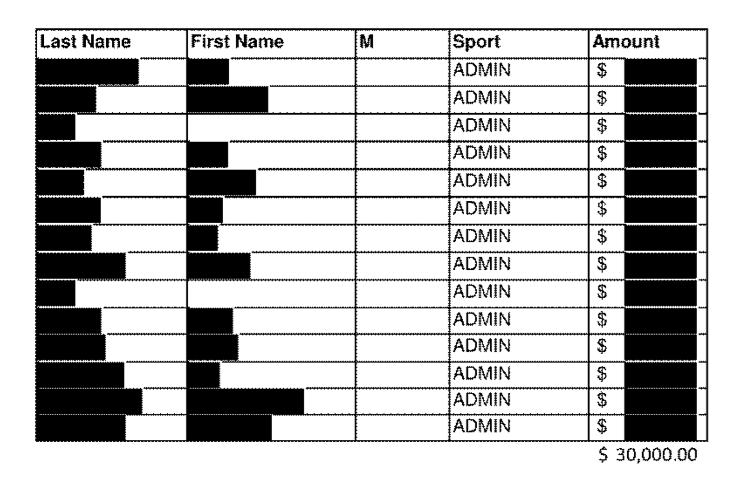
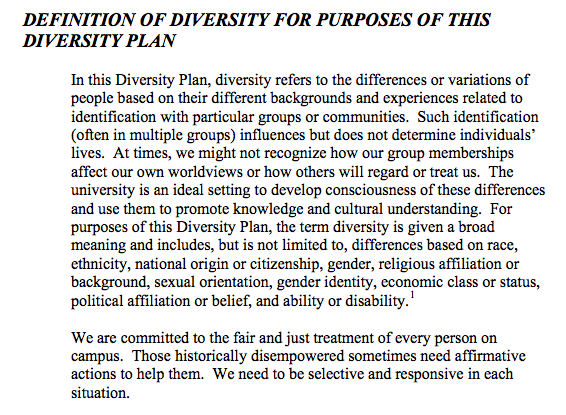
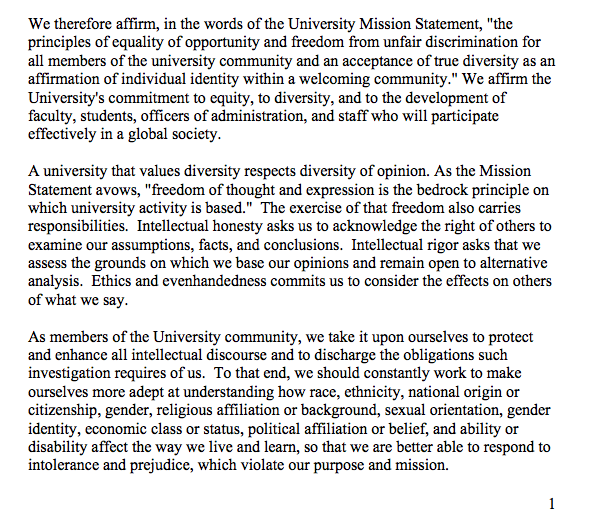
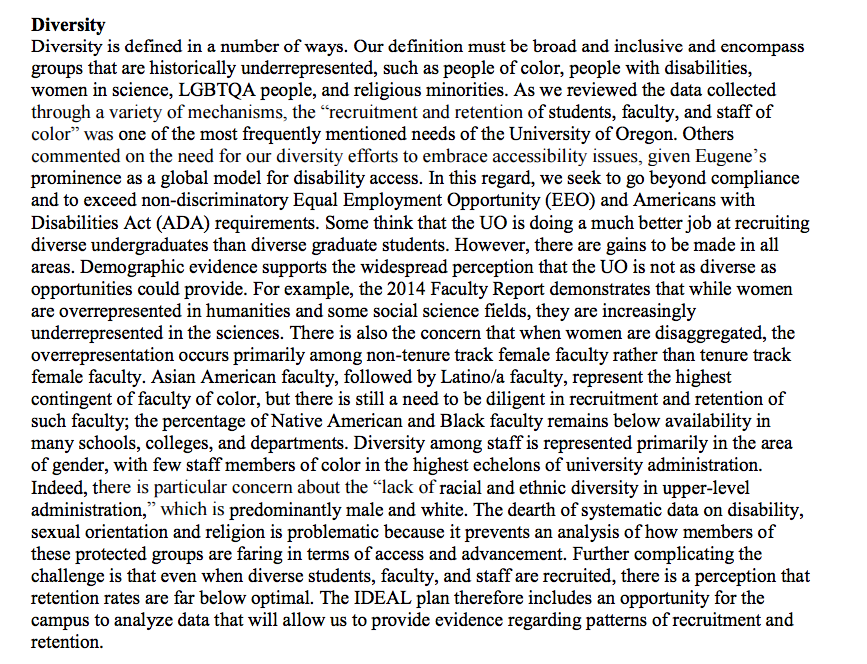
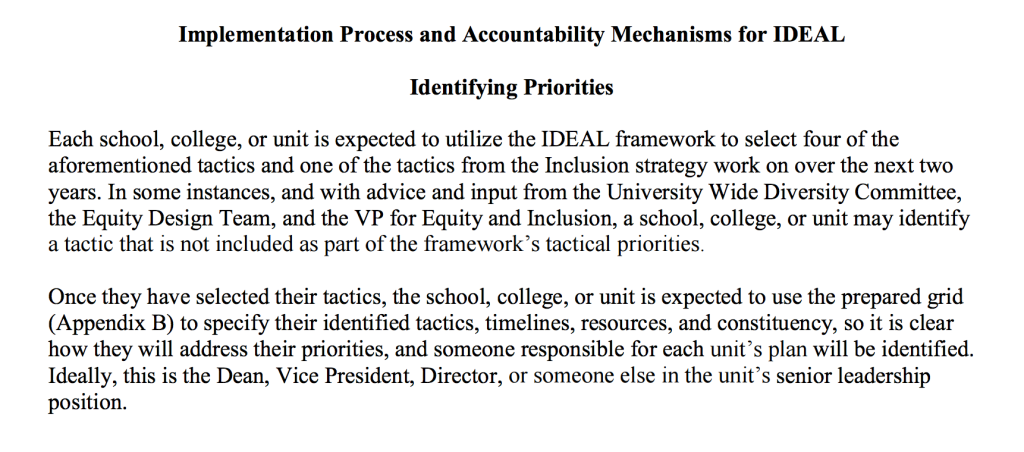
IT part is pretty disappointing. Lots of strange decisions no one who clearly understands in charge.
Spending money on IT infrastructure or HPC resources before the mgt teams to manage them is in place is extremely unwise. Seems like you are only going to handicap the new staff with decisions made without their expertise. Which is the point of hiring them.
Looks like typical U of O mgt style. No real sense of the reality on the ground.
“Reynold and Reed then discuss the progress on hiring a permanent replacement for MacAllister – sounds like finalists should be on campus in a month or so.”. Worrisome that after McAllister (20 years experience in creating and facilitating Ombuds programs) and Reynolds (harvard grad) they are interviewing “finalists” with very little experience, especially as the new “mandatory reporter” and hearing SOPs go into effect. Could admin or counsel be looking for newbies on purpose to toe the party line?